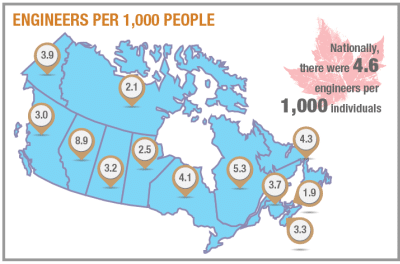Getting your PEng license in Canada is rewarding, and perhaps a goal you've had for a long time. So that we're on the same page, PEng (or P.Eng. as it should be written) stands for professional engineer.
Let's look at what's involved.
PEng License Steps
There are mandatory steps that you will need to meet in order to earn your PEng licence. Other steps, like technical exams, might only apply to certain applicants.
There are two common paths to getting your license — yours will depend on if you received your university degree in Canada or abroad. I'll put the challenging steps in bold, so you know those steps take more time and effort.
International Grad — Steps to a P.Eng.:
- Submit PEng license application
- Academic assessment
- Write technical exams (if applicable)
- Submit your Competency-Based Assessment (CBA)
- Write National Professional Practice Exam (NPPE)
- Wait for board approval
Canadian Grad — Steps to a P.Eng.:
- Submit PEng license application
- Write National Professional Practice Exam (NPPE)
- Submit Experience
- Wait for board approval
Let's look at each step individually.
 Submit PEng License Application
Submit PEng License Application
---(step 1 for both types of grads)---
Submitting your application is fairly straightforward. You'll fill out a form (might be PDF or in a members' portal) and provide the following:
- name
- proof of identity
- address
- academic background
- transcripts (international grads only. Translation may be required if they are not in the language of your association)
- employment details
- references
- good character declaration
- application fee
 Academic assessment
Academic assessment
---(step 2 for international grads)---
Canadian engineering grads don't have to worry about this step if they completed an accredited engineering program (which is most engineering schools in Canada). For those educated outside of Canada, you'll typically have your school send your association transcripts and arrange for translation (if required). Your association will compare your courses with a Canadian equivalent degree. If there are any gaps, they may assign you technical exams which we'll talk about next.
 Write technical exams
Write technical exams
---(step 3 for international grads, if applicable)---
International grads who are missing courses, when compared to a Canadian engineering degree, may be asked to write anywhere between 1 and 10 technical exams (some associations limit it to 4). Typically, they are required to write some basic studies (e.g. mathematics), complimentary studies (e.g. economics) and technical topics that relate to their degree (e.g. civil, mechanical, electrical).
If you would like to see the level of difficulty, here is a collection of old technical exams (questions only). For help with over 40 exam topics, please visit our technical exam solutions page.
 Submit your Competency-Based Assessment (CBA)
Submit your Competency-Based Assessment (CBA)
---(step 4 for international grads; step 2 for Canadian grads)---
The Competency-Based Assessment (CBA) reporting system is used in most provinces across Canada. While there are slight variations between provinces, you can expect to write between 22 to 34 highly specific examples (e.g. Tell us when you used codes and standards to solve a problem). The common themes you will be writing about fall into these categories:
- Technical Competency
- Communications
- Project & Financial Management
- Team Effectiveness
- Professional Accountability
- Social, Economical, Environmental & Sustainability
- Personal Continuing Professional Development
For help with this licensing step, we have the following courses:
- 34 CBA Course (PEO, EGBC (engineers only), APEGNB, APEGS, EGM, PEGNL or Engineers PEI)
- 22 CBA Course (APEGA, NAPEG, or Engineers Yukon)
NPPE
---(step 5 for international grads; step 3 for Canadian grads)---
This step is often referred to as the law and ethics exam. It consists of 110 multiple-choice questions that span the topics of law, ethics and professional practice as they relate to engineers and geoscientists. If possible, allow 5 weeks of study at 1 hour per day. You can get started with our free NPPE mini-course to get our lessons and practice questions related to syllabus topic one which covers professionalism.
Wait for board approval
---(step 6 for international applicants; step 4 for Canadian applicants)---
All your documents are in by this time, and you've met the licence requirements. The staff at your association have recommended you receive your licence. The final step is board approval. The board sits about once a month but may take off the month of December. Waiting for this step can take up to 2 months.

Where should you apply for your PEng license?
If you haven't selected your association yet, it is advisable to pick one based on where you live and plan on doing most of your projects. This is normally dictated by where your company's office or projects are. Talk to your manager to see what makes the most sense with your company. Below is a map of Canada to show the concentration of engineers across Canada.
What part of the licensing journey are you most concerned about? Please leave us a comment below or contact us with your questions.

Thank you for reading. What PEng licence step do you worry about the most? What have you found the easiest? Leave us your comments here or contact us at https://practiceppeexams.ca/company/contact-us/
What does ITC MEAN WHEN DISPLACED AFTER P.Eng?
Hi Ron,
We’ve never seen that before. Perhaps you can ask the person who’s using that title. Or maybe it is a different designation. Feel free to reach out if you need help with the licensing process [email protected]
I am Idowu Olusegun by name, Male 52yrs of age ,a Nigerian citizen and presently in Canada now as my son just filling (PR) for me and his mum being a citizen here in Canada. I started my carrier from technical education far back in1991 and graduated in 1994. as a criteria for your completion at the school, you need to pass the three stages of city and guild exams then and which i did and passed the three stages and graduated as the best Electrical Student of the year then at the technical school owned by West African Portland Cement . I later proceed for a part time studies at the Polytechnic Ibadan for my National and Higher National diploma on Part time bases while i work with different establishment during my schooling as no one to fund my education. i had been running my personal Engineering firm that i registered with Nigeria corporate affairs commission far in 2007. I work with my firm till date but thinking of relocating to Canada recently because of the economic situation of Nigeria and insecurity there in.
How will you advise me?
Hi Idowu,
I’m emailing you now.
Hi, I am Fathima, planning to migrate to Canada with PR after 2 months with 4 years experience. Should I start my PEng application now or after landing in Canada? How long will it take usually for the application to go through? Will I not get any core technical jobs in Canada until I receive my PEng license?
I am a structural engineer btw.
Thanks in advance for addressing my queries
Hi Fathima,
Great questions. Here are your answers:
1. 2 months won’t make a big difference. If you have time now, you can get started with the province your will be living in.
2. There is an initial application and then there are exam(s) and submitting your competency based assessment (CBA). Please allow 1 year to get through the entire process if you are working closely with the Practice PPE Exams team. If you are going through the steps on your own, it might take up to 2 years.
3. For job searches, it is best to look at job boards to see what qualifications they are looking for. Without a P.Eng. you won’t be able to take responsibility for professional work products (PWPs), but you could support a P.Eng. with their work. Then, when you get your licence, you can start taking on more responsibility.
Hello
My name’s Okedele Ayodeji
I’m a new immigrant in Canada with an 8years experience in engineering practice.
I hold Bachelor’s and diploma in mechanical engineering from Nigeria institutions as well as Certificate in Robotics from a USA institution.
I have worked in Nigeria and in the United States(as intern)
My credentials has been evaluated to Canadian standard.
I’m a registered engineer from Nigeria and I have some international trainings abroad.
I’m seeking for part way to being registered as a professional engineer in Canada so I can continue my career in engineering.
I’ll appreciate your response through the email I provided.
Thank you
Hi Okedele,
We will be very happy to assist you in your licensing journey. We’ll reach out to you through the email your provided.
Hello
I’m currently in Canada on SOWP with an 8years experience in engineering practice.
I hold Bachelor’s degree in Civil engineering (Nigeria) and a Master’s degree in Structural Engineering (UK).
I’m a Registered/Certified Engineer in Nigeria.
I’m seeking for path way to being registered as a professional engineer in Ontario so I can continue my career in engineering.
I’ll appreciate your response through the email I provided.
Thank you
Hi Taofik, please email us your inquiries at [email protected], we’ll be glad to assist you.
Hi,
I have MSc and BSc in geosciences but I have only worked as telecom engineer. I will be rounding up another masters degree in Engineering management in Canada in coming weeks, would your recommend I apply for P.gEO OR P.Eng? Thanks
Hi Kunle,
Thank you for subscribing to our newsletter.
Kindly email your question to [email protected] so we can discuss your question. We look forward to hearing from you.